Is It Possible To Overfeed A Gecko? [4 Signs]
As a keeper, seeing your gecko eat with great gusto pretty much serves as a sufficient reinforcement for you to give it even more of its favorite food – be it a cricket or a superworm. But an important question to ask yourself is: are you giving too much?
Geckos can be overfed and there are 4 signs that can indicate gecko overfeeding: 1) decrease in overall activity, 2) food regurgitation immediately after eating, 3) tail thicker than the neck, and 4) rounding out of other body parts. Overfeeding causes obesity and leads to the development of serious diseases.
If any of the things I mentioned above rings true for you, just keep reading!
4 Signs of an Overfed Gecko
To this day, some keepers still insist that there is no such thing as overfeeding geckos. Experts and experienced keepers, however, would probably beg to differ.
Listed below are 4 tell-tale signs that you have been overfeeding your colorful reptilian buddy.
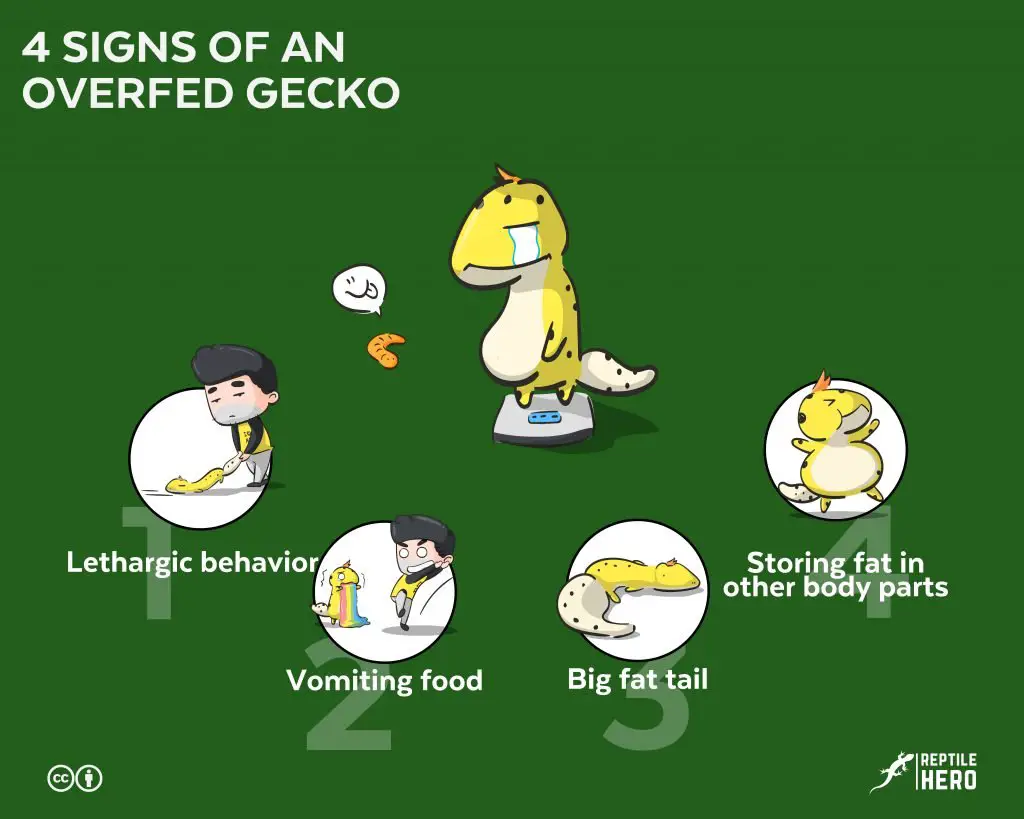
1. Lethargic Behavior
A little fun fact: geckos can also experience food coma.
Yes, you read that right.
Extreme lethargy in these creatures is a sure sign of overfeeding. Geckos who become less active and curious are mistakenly thought to be just tame by keepers. It’s important for all reptile owners that these are naturally active animals.
Of course, we should take into consideration what times of the day our pets are most active. Diurnal geckos are more active during the day, when the sun is still up. Nocturnal geckos, on the flip side, are more active during the night, when the sun is no longer in sight.
2. Vomiting Food
A clear evidence of unhealthy and excessive eating in geckos is vomiting.
No matter how much they overindulge in their favorite live feeder insects, whatever their stomach can no longer handle will be thrown up.
They will cough up partially eaten and digested food like this:
3. Big Fat Tail
Our reptile companions store fat and other nutrients in their tails. By doing so, they can survive in the wild even when there is little food available.
Ergo, a thick tail is generally evidence of good diet and health. However, a gecko having an exceptionally big and fat tail doesn’t mean it’s in tip-top shape – it’s more of the opposite actually.
Huge tails could actually mean that your gecko is well on it’s way to becoming obese and contracting serious illnesses which could prove fatal.
So when does a gecko’s cute and plump tail become a sign of overfeeding? Well, it’s really simple: the widest part of their tail shouldn’t be any thicker than their neck and head. When their tails start becoming fatter than their bodies, they’ve reached the point of obesity.
Do keep in mind that this simple indicator for overeating is only applicable to adult geckos who have not dropped their tails. After losing their tails, geckos naturally need more nutrition for tail regeneration. And once their tails grow back, you will notice that it has become chunkier than before and thicker than their necks.
4. Storing Fat In Other Body Parts
Once geckos have maxed out the fat storage capacity of their tails, they begin to store excess fat in other parts of their bodies. To be more specific, you will notice how their midsection, limbs, armpits, and even their heads start to put on a lot of weight, blowing up like balloons.
Normally, geckos have stomachs that are on the flatter side of things – that is, unless they have just finished their meals.
So if you’ve observed that your gecko has been sporting an overly round belly several hours or days after his/her last feeding, he/she has definitely gone past putting on a healthy weight. Other geckos may also develop belly rolls.
As time passes, their limbs may start looking stubbier and stubbier; like small, short, and fat sausages.
They may even start getting air bubbles near their armpits. You may mistake them for simple lumps or swollen blisters by one or both pits. Air bubbles start functioning like gecko tails, storing fat and other things absorbed from the food they eat.
The heads of overfed geckos can also get quite visibly distended, to a point where their eyes seem to start sinking into their flesh.
Although these build-ups are relatively harmless, they won’t go away without any change in their diet.
2 Reasons Why Your Gecko Eats So Much
Although most geckos generally stop eating once they have their fill, there are still a few who keep on eating as long as they see food – even when they’re pretty much already bursting at the seams. And there are 2 major reasons behind gecko overeating.
1. Still young, still growing
Any keeper of baby geckos, regardless of whether they’re newbies or veterans, will attest to the fact that these cute little multicolored lizards are tremendously voracious feeders. They could easily scarf down numerous insects in under 10 to 15 minutes.
This is to be expected as baby geckos need to eat as much as they can every single day up to ensure healthy growth. Geckos use up all the fat and nutrients from the insane amount of food they eat to bulk up.
Upon growing into their juvenile stage they will begin to eat less and less because they slowly near their healthy weight as every month passes. In adulthood, their weight generally plateaus out.
2. Giving in to animal instincts
A natural behavior geckos exhibit is to eat everything they see. This is something they have inherited from their ancestors who faced harsher environments in the wild.
In their natural habitats, the availability of food is never certain so they have developed the habit of overeating to survive the yearly seasonal changes (affecting humidity and temperature levels) and the lack of food due to competition and the presence of larger predators.
Once in captivity, geckos learn that they are able to feed regularly and not suffer from starvation. They learn when to stop eating.
Still, others continue to eat every single insect they can to ensure that they never have to worry about starvation – an instinct they have failed to shake off.
Also, offering geckos too much food too frequently will lead to overeating. This is why setting up a schedule for feeding is important.
When Can Geckos Be Fed Large Amounts of Food?
As a golden rule, I would say that it’s generally not okay to let your gecko keep eating so much. However, there are some exceptions to that rule:
• If it still a hatchling or a juvenile still on a growth spurt
• If it’s pregnant or about to go into breeding
• If it recently dropped its tail
• If it’s a rescue who was previously starved
How To Tell If Your Gecko is Anorexic, Healthy, or Obese
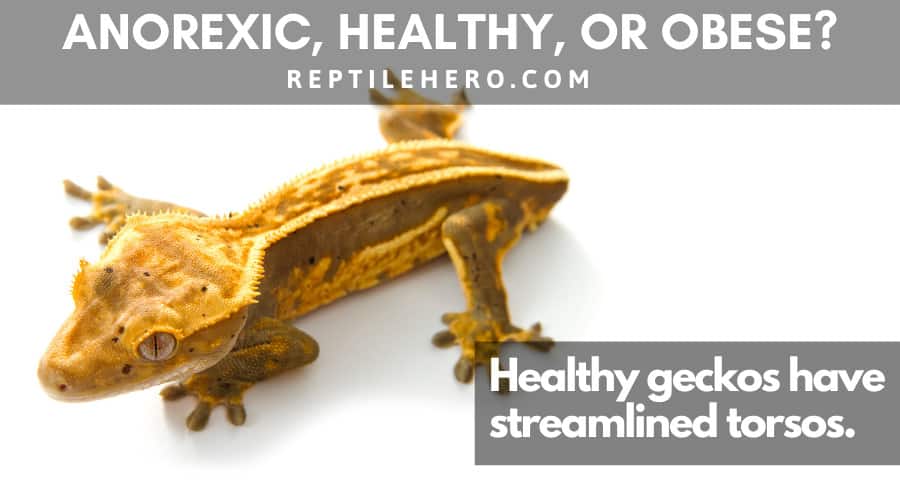
Geckos are diverse in species, color, pattern, shapes, and sizes. The tiny dwarf gecko, known for being the smallest lizard, only weighs around 120 milligrams on average. On the other hand, the New Caledonian giant gecko, known for being the largest gecko, can weigh up to 279 grams.
Now knowing all of that, it’s safe to say that merely basing your gecko’s overall health on just their weight would give you quite an inaccurate impression.
Doctors of veterinary medicine use a system called Body Condition Score (BDS) to determine whether your gecko is healthy or not. This species-specific scoring system ranges from 1 to 9:
- 1 indicates emaciation – leg bones, pelvis, skull, rib cage, and spine are prominent through the skin due to lack of fat and muscle; eyeballs sinking far into the sockets; stick tail
- 5 marks a normal and healthy weight – torso is streamlined; tail is more or less as thick as the body
- 9 demonstrates obesity – visibly thick midsection; fat backs and sides make rib cage and spinal cord impalpable; fleshy jowls; torso is shaped like a pear; tail fatter and thicker than body
Others claim that the most accurate way to tell whether a gecko is healthy or not can be measured through a simple equation:
The results from this equation should of course be judged depending on their species. Keep in mind that a gecko’s snout-vent length (SVL) is measured from the tip of its mouth to the point where the tail begins. However, data for comparison for certain species kept in captivity is still lacking.
Another fact to take into consideration when determining your gecko’s overall health: female geckos are smaller and lighter than their male counterparts in general.
Serious Conditions Geckos Develop Due To Overfeeding
Although the bonding time you get to spend with your geckos during feeding is priceless, it’s crucial to not go overboard with it. Overfeeding causes overweight and obesity in reptiles. And it doesn’t end with just putting on a few grams. It may actually lead to the onset of numerous conditions that may put their lives on the line.
Fatty Liver Disease
A few geckos are frugivorous, eating fruits every now and then. However, like most other geckos are strictly insectivores, live feeders are a diet staple. But this doesn’t mean you can just feed geckos any kind of insect.
Having geckos overeat while on a diet that consists mostly of feeders high in fat like superworms, butterworms, waxworms, and mealworms is sure to give your pet fatty liver disease (FLD).
FLD, also referred to as hepatic lipidosis, happens when overweight and obese geckos start transferring fat stored in their tails into their livers to continue the metabolic process. However, because of the gross amount of fat dumped into it, geckos stop metabolizing it and instead start storing it there.
As a result, the liver is unable to function optimally – basically wearing out the immune system along the way. This makes geckos especially susceptible to infections from bacteria, viruses, and fungi.
According to research, hepatic lipidosis has been constantly recorded to cause death in a number of various reptile species.
Gout
Feeders high in protein include dubia roaches, crickets, and mealworms. A protein-rich diet is indeed good as long as other nutritional needs (vitamins, fat, calories, etc.) are met
However, too much of anything can never be a good thing. Geckos who are overfed with a diet rich in protein and not much else are at even higher risk of developing gout.
It is a grave metabolic disorder lizards contract due to the elevated levels of uric acid found in insect protein. When uric acid enters the bloodstream, it creates crystalline structures that accumulate in different parts of the body disrupting normal functions.
Gout may be classified into two ways:
- Primary – caused by an oversupply of uric acid
- Secondary – caused by other conditions that disrupt uric acid absorption, production, and secretion
There are also two manifestations of gout:
- Articular gout – uric acid accumulates in the joints
- Visceral gout – uric acid accumulates in organs; namely the spleen, liver, kidneys, lungs, heart, and/or mucous membranes
Bowel Impaction
As I have repeatedly mentioned before the type of insects your geckos have been feeding on also greatly influences their well-being. But that doesn’t just concern their nutritional values.
Mealworms, compared to other feeder insects, contain astronomical amounts of chitin. This naturally occurring substance coats the outer skin and is responsible for its hardiness.
A gecko diet primarily consisting of live feeders with hard exoskeletons can negatively affect digestion. As such, many hobbyists are strongly advising against the frequent feeding of mealworms as it can lead to bowel impaction.
Post-Ovulatory Stasis
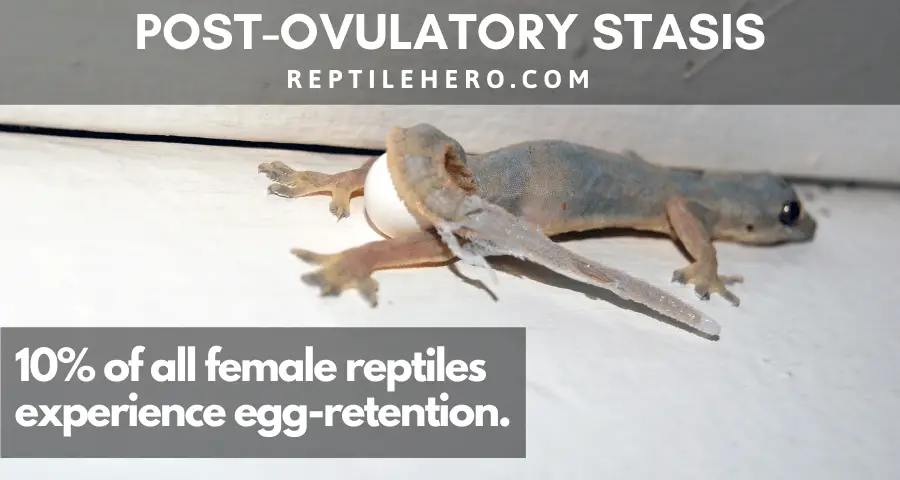
The majority of pet gecko owners probably think that poor husbandry, inadequate lighting, improper temperature settings, insufficient nesting space, dehydration, and malnutrition are the only factors that lead to post-ovulatory stasis.
So it may come as a surprise for some that obesity brought about by improper diet can also actually cause it.
This disease has many other names: dystocia, egg-binding, and egg-retention. It is a condition wherein female geckos are unable or experience great difficulty in getting mature eggs out of their bodies.
You will see gravid geckos raise their hindquarters and strain to pass eggs without any success. They may also experience symptoms such as depression and lethargy. In severe cases, it may lead to the death of yet-to-hatch baby geckos, issues of infertility, and even the death of prospective mother geckos.
Unfortunately, dystocia is incredibly common not just in geckos but the entire reptilian population. To be more specific 10% of all female reptiles go through this.
How Much And How Often Should You Feed Your Gecko?
Many new gecko owners find themselves in a pickle when it comes to feeding their babies the “right way.” Because different forums, blogs, and websites give different suggestions on how much and how often to feed geckos, things can be quite confusing.
What’s more is that many factors should be considered when feeding geckos: temperature, lighting, time of the day, breeding season, etc.
And so I took it upon myself to do in-depth research, comparing different practices for different species for a general guide. Here’s what I came up with.
| Gecko Age (Months) | How Much To Feed Them | How Often To Feed Them |
|---|---|---|
| Hatchling(Birth – 4 months) | 4-10 insects | Every single day |
| Juvenile(4 – 18 months) | 10-16 insects | Every single day↓Every other day |
| Adults(18 months and above) | 20 insects | Every other day↓Once/twice a week |
If you have a leopard gecko in particular, you can watch this video for a more specific guide on proper feeding frequency and amount.
How To Make Sure Your Gecko Doesn’t Become Obese
The ‘chonky’ pet trend did give us endearing pictures of adorable chubby geckos. However, this trend didn’t come without any problems. As responsible pet owners, we must always remind ourselves that their health should be our top priority.
To make sure our geckos only put on a healthy amount of weight, we should keep in mind the following:
- Never give your geckos a diet of only one feeder insect. Feeding solely on a single type can result in many diseases. Offer them a variety of gut-loaded and dusted insects. Give them appropriate supplements and only give them treats once in a while;
- Encourage activity within their vivariums; get reptile hammocks and vines for geckos to climb onto. Let them hunt for their live food regularly;
- Optimize their vivarium set-up in accordance with their needs. Put plants, branches, hides – try to mimic their natural habitats as best you can.
Geckos already overweight could also benefit from the previously mentioned pieces of advice.
Takeaways
- Geckos can be overfed. You’ll know they’ve been overfed if they’re lethargic, vomiting partially eaten food, have really fat tails, and are getting fat in other body parts.
- Overfeeding causes obesity, which in turn leads to the development of life-threatening diseases such as fatty liver disease, gout, impaction, and egg-retention.
- Proper diet, regular exercise, and an optimum tank environment all help geckos maintain a healthy weight.
reptilehero.com is part of the Amazon Services LLC Associates Program, an affiliate advertising program designed to provide a means for sites like mine to earn advertising fees by promoting good quality Amazon.com products. I may receive a small commission when you buy through links on my website.

![Do Geckos Drink Milk? [Think it Twice]](https://www.reptilehero.com/wp-content/uploads/2021/07/Does-Gecko-Drink-Milk-Infographic-768x614.jpg)

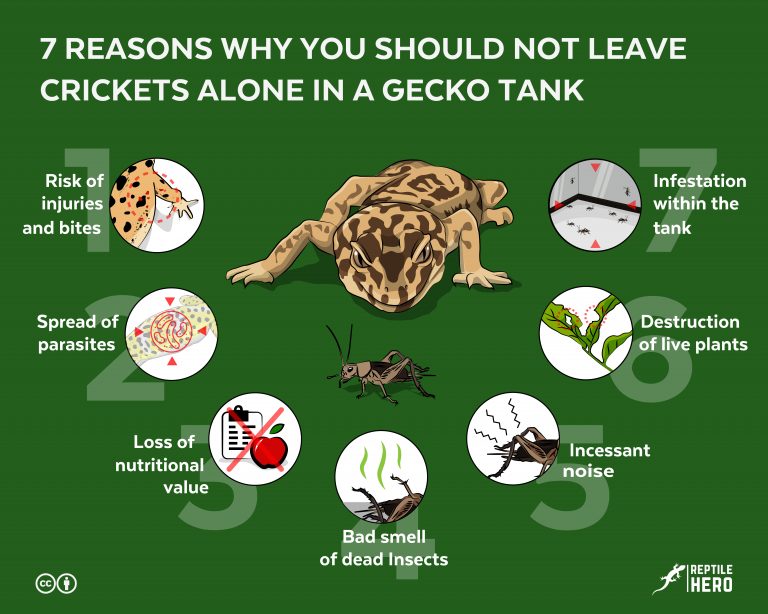
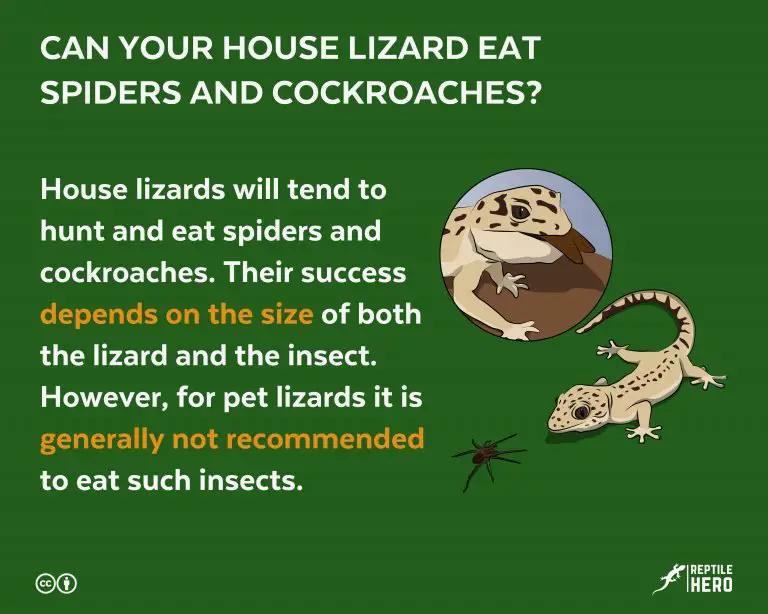
![Can Your Gecko Eat Waxworms? [3 Things You Must Know]](https://www.reptilehero.com/wp-content/uploads/2021/06/Can-gecko-eat-waxworm-infographic-768x614.jpg)
![Picky Eater Leopard Geckos – How To Feed it [8 Solutions]](https://www.reptilehero.com/wp-content/uploads/2021/12/picky-eater-gecko-cc-768x614.jpg)